 W
WAbul Wafa is an impact crater located near the lunar equator on the far side of the Moon, named after the Persian mathematician and astronomer Abu al-Wafa' Buzjani. To the east are the crater pair Ctesibius and Heron. In the northeast lies the larger crater King, and to the southwest is Vesalius.
 W
WAl-Biruni is an impact crater that lies on the far side of the Moon, just beyond the eastern limb. This portion of the surface is sometimes brought into sight due to librations of the Moon, but due to its location the crater is viewed from the side. Al-Biruni lies to the south of the crater Joliot, and to the northeast of Goddard. It is named after the great Ghaznavid Scientist Al-Biruni.
 W
WAl-Khwarizmi is a lunar impact crater located on the far side of the Moon. It lies to the southeast of the crater Moiseev, and northeast of Saenger.
 W
WArtamonov is a lunar impact crater that is located on the far side of the Moon. The eroded outer rim of Artamonov does not have the circular shape of most lunar craters, and instead has the overall shape of three or four merged craters. The largest of these formations is in the south, with smaller circular bulges to the north and east.
 W
WBabcock is a lunar impact crater that is located on the far side of the Moon. It was named after American astronomer Harold D. Babcock. It lies on the northeastern edge of Mare Smythii, to the southeast of Mare Marginis. To the south of Babcock is the crater Purkynĕ, and to the east-northeast lies Erro. Babcock is located in a region of the Moon's surface that is occasionally brought into view during favorable librations, although it is seen from the edge and so little detail can be discerned from an observer on the Earth.
 W
WBingham is a small lunar impact crater that is located on the far side of the Moon, relative to the Earth. It is named after the American academic, explorer and politician Hiram Bingham III. It lies just to the southeast of the much larger crater Lobachevskiy, and the northwestern part of the rim of Bingham is partly overlaid by ejecta from Lobachevsky. To the northeast of Bingham is the crater Guyot, and about a crater diameter to the south-southeast is Katchalsky. This is a roughly circular crater formation with a slight outward bulge along the southeastern side.
 W
WChang Heng is a lunar impact crater that is located on the Moon's far side. It lies less than one crater diameter to the northeast of the walled plain Fleming. The rim of this crater is somewhat eroded, with a pair of small craters along the northern rim and tiny craters along the south and east edges. The interior floor contains a small, concentric crater that is about one third the diameter of Chang Heng. The crater is named after Chinese astronomer Zhang Heng.
 W
WCtesibius is a small lunar impact crater that is located near the equator, on the far side of the Moon. It is named after the ancient Greek-Egyptian inventor Ctesibius. It lies between the larger crater Abul Wáfa to the west and the slightly smaller Heron to the east.
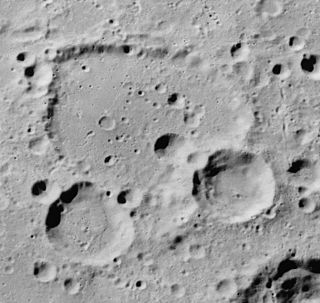 W
WDeutsch is a lunar impact crater on the far side of the Moon. It lies to the southwest of the larger crater Seyfert. About one crater to the east-northeast is Polzunov.
 W
WDreyer is the remnant of a lunar impact crater on the far side of the Moon. It is located along the eastern edge of the Mare Marginis, about midway between the craters Ginzel to the north and Erro to the south-southeast. It was named after Danish-Irish astronomer John L. E. Dreyer.
 W
WDziewulski is a lunar impact crater on the far side of the Moon. It lies between the craters Edison to the north and Popov to the south. The outer rim of this crater has been considerably worn by impacts, particularly along the southwest quadrant where the satellite crater Dziewulski Q overlies the rim and the interior floor. The northern rim is also heavily disrupted, and several small crater lie along the southeast rim. The interior floor and surrounding terrain has been resurfaced.
 W
WEdison is a lunar impact crater on the far side of the Moon. It is located just behind the north-northeastern limb of the Moon, a region that is sometimes brought into sight from Earth during favorable librations. However even at such times not much detail can be discerned, and the crater is better observed by orbiting spacecraft.
 W
WErro is a lunar impact crater that lies beyond the eastern limb of the Moon, on the far side as seen from the Earth. It lies along the eastern fringes of the uneven plain that joins Mare Marginis to the northwest with Mare Smythii to the west-southwest. This part of the surface is sometimes brought into sight of observers on the Earth due to libration. However even at such times not much detail can be seen, as the surface is viewed from the edge.
 W
WEspin is a lunar impact crater that lies on the far side of the Moon, just beyond the northeastern limb. It lies to the west-southwest of the larger crater Seyfert, and northwest of Deutsch.
 W
WFirsov is a lunar impact crater on the far side of the Moon. It is located to due south of the crater Lobachevskiy, and to the northwest of Abul Wáfa. The circular rim of this crater has a small outward bulge along the southern edge, and smaller bulges along the western side. The inner walls have slumped to form talus piles along the base. The low-albedo interior floor is nearly level and featureless.
 W
WFleming is a large lunar impact crater that is located on the Moon's far side, and cannot be seen from the Earth. It lies about a crater diameter to the east-northeast of Hertz, and to the northwest of Lobachevskiy.
 W
WFlorensky is a lunar impact crater that is attached to the northeastern rim of the larger crater Vernadskiy. It is located on the far side of the Moon and cannot be directly seen from the Earth. The rim of this crater has been heavily eroded and it forms an irregular ring about the uneven interior. This crater was previously identified as Vernadskiy B before being assigned a name by the IAU in 1985.
 W
WFox is a small lunar impact crater on the far side of the Moon. It is named after the American astronomer Philip Fox. It lies near the northern rim of the crater Wyld, and to the southeast of Babcock. This crater is bowl-shaped, with a roughly circular rim, simple sloping walls and a relatively level, featureless interior. There is some talus along the northern inner wall.
 W
WGavrilov is a lunar impact crater on the far side of the Moon. It lies to the south of the heavily eroded crater Vernadskiy, and north of Vetchinkin.
 W
WGinzel is a lunar impact crater that is located on the far side of the Moon, just beyond the eastern limb. It is named after the Austrian astronomer Friedrich Karl Ginzel. It lies at the eastern edge of the Mare Marginis, in a region of the surface that is sometimes brought into sight of the Earth due to libration. To the north-northeast of Ginzel is the crater Popov, and Dreyer lies due south.
 W
WGreen is a lunar impact crater on the Moon's far side. It was named after British mathematician and physicist George Green in 1970. Prior to that, it was designated Crater 216. It lies just to the west of the huge walled plain Mendeleev, and is nearly joined with the west-northwestern edge of the crater Hartmann.
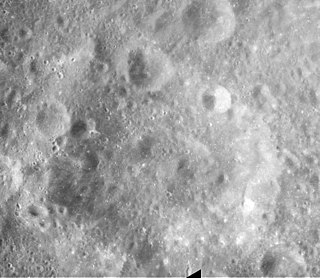 W
WGregory is a lunar impact crater on the far side of the Moon. It is named after the 17th century Scottish astronomer and mathematician James Gregory. It is located to the southeast of the crater Ibn Firnas, and north-northeast of Bečvář. About one crater diameter to the north is the smaller Morozov.
 W
WGuyot is a lunar impact crater on the Moon's far side. It is separated from the crater Kostinskiy to the northeast by only a few kilometers of rough terrain. To the west-southwest lies the crater Lobachevskiy and to the east-southeast is Ostwald.
 W
WHeron is a small lunar impact crater that lies on the far side of the Moon, less than 20 kilometers from the equator. It lies between the slightly larger crater Ctesibius just to the west and Soddy a little farther to the east. Almost directly to the north is the prominent crater King.
 W
WHertz is a lunar impact crater that lies on the far side of the Moon, just behind the eastern limb. Due to libration this feature can sometimes be observed from the Earth under favorable lighting conditions. It is located to the west-southwest of the larger crater Fleming and north-northeast of the smaller Moiseev. Moiseev is joined to Hertz by the satellite crater Moiseev Z, and the three form a short crater chain.
 W
WIbn Firnas is a lunar impact crater on the far side of the Moon. In 1976 it was named after Abbas Ibn Firnas, a polymath from Andalucia who, in the 9th century, devised a chain of rings that could be used to simulate the motions of the planets and stars.
 W
WIbn Yunus is the remains of a flooded lunar impact crater. It lies on the far side of the Moon, just past the eastern limb. It can only be viewed from Earth under conditions of favorable libration and lighting, and even then it is seen from the edge. This feature is attached to the east-southeastern outer rim of the flooded crater Goddard. It lies within the Mare Marginis, a lunar mare along the eastern limb.
 W
WInnes is a lunar impact crater on the Moon's far side. It is located less than a crater diameter to the east-southeast of the prominent crater Seyfert. To the southeast of Innes is the crater Meggers, and to the west-southwest lies Polzunov.
 W
WJoliot is a large lunar impact crater that lies on the far side of the Moon, just past the eastern limb. At this location it lies in a region of the surface that comes into sight during a favorable libration, although at such times it is viewed from the side. Thus viewing this crater in detail must be done from orbit.
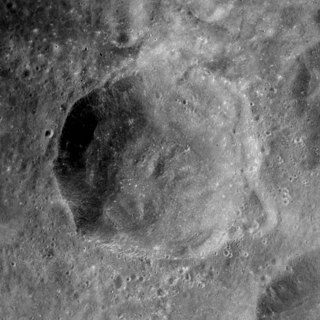 W
WKatchalsky is a crater that lies on the far side of the Moon. It was named after scientist Aharon Katzir-Katchalsky. It lies to the southeast of the larger crater Lobachevskiy, and to the west of the prominent King. Less than a half-crater diameter to the southeast of Katchalsky is Viviani.
 W
WKing is a prominent lunar impact crater that is located on the far side of the Moon, and can not be viewed directly from Earth. The crater was named after Arthur Scott King and Edward Skinner King in 1970. Prior to that, this crater was known as Crater 211. It forms a pair with Ibn Firnas, which is only slightly larger and is attached to the northeast rim of King. To the northwest is the crater Lobachevskiy, and Guyot is located an equal distance to the north-northwest.
 W
WKostinsky is a lunar impact crater on the far side of the Moon. It is nearly attached to the northeastern outer rim of the crater Guyot. About one crater diameter to the southeast is Ostwald, and farther to the north is Olcott.
 W
WLobachevskiy is a lunar impact crater that is located on the far side of the Moon, beyond the eastern limb. It was named after Russian mathematician Nikolai Lobachevsky in 1961. This crater lies to the southeast of the larger crater Fleming. Less than a crater diameter to the east-northeast lies Guyot.
 W
WLomonosov is a lunar impact crater that is located just behind the western limb of the Moon. It is almost attached to the east-northeastern outer rim of the larger crater Joliot, and overlies the southern rim of Maxwell. Attached to the southern rim of Lomonosov is the smaller Edison.
 W
WThe Lunar Orbiter 2 robotic spacecraft, part of the Lunar Orbiter Program, was designed primarily to photograph smooth areas of the lunar surface for selection and verification of safe landing sites for the Surveyor and Apollo missions. It was also equipped to collect selenodetic, radiation intensity, and micrometeoroid impact data.
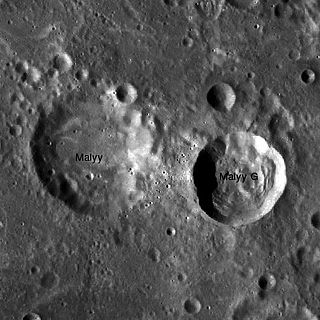 W
WMalyy is a damaged lunar impact crater that lies on the far side of the Moon, behind the eastern limb as seen from the Earth. It is located to the south-southeast of the crater Artamonov. Slightly farther to the east-northeast lies Deutsch. The quadrant of terrain to the southwest of Malyy forms a nearly level plain marked by small craters and buried features.
 W
WMcAdie is a flooded lunar impact crater that is located along the northeastern edge of Mare Smythii, on the far side of the Moon. It lies just to the southwest of the larger, flooded Babcock. During periods of favorable libration and illumination, this area can be viewed from the Earth, although it is seen from the edge and not much detail can be discerned.
 W
WMeggers is an impact crater that lies on the far side of the Moon. It was named after American physicist William F. Meggers.
 W
WMeshcherskiy is an impact crater that is located on the Moon's far side, to the east-northeast of the larger Ostwald. To the east-southeast of Meshchersky is the crater Vetchinkin.
 W
WMöbius is a lunar impact crater that is located on the Moon's far side, beyond the eastern limb and northeast of the Mare Marginis. It lies less than one crater diameter to the northwest of the larger, 90-km-diameter Hertz, and just to the southeast of Popov. To the north of Mobius is the crater chain designated Catena Dziewulski, which takes its name from the crater Dziewulski to the north-northwest.
 W
WMoiseev is a lunar impact crater that is located just on the far side of the Moon. It lies to the south-southwest of the slightly larger crater Hertz, and north of Saenger. To the southeast lies the irregular crater Al-Khwarizmi.
 W
WMons Ardeshir is one of the mountains on the Moon, inside crater King. Its diameter is 8 km. In 1976 it was named after Persian male name Ardeshir.
 W
WMons Dieter is a mountain (hill) on the Moon, located in King, an impact crater, at 5.00°N 120.30°E. It has a diameter of 20 kilometres (12 mi). The mountain was named Dieter, a German male name, in 1976. The mountain is never visible from the Earth, as it is located on the far side of the Moon.
 W
WMons Dilip is a mountain (hill) on the Moon, located in King, an impact crater, at 5.35°N 120.51°E. The mountain was named Dilip, an Indian male name, in 1976.
 W
WMorozov is a lunar impact crater that is located on the far side of the Moon. It was named after Russian natural scientist Nikolai Morozov. It lies to the north of the crater Gregory and to the east-southeast of Ibn Firnas. Less than two crater diameters to the west-southwest of Morozov is Zanstra.
 W
WNunn is a lunar impact crater that is located just beyond the eastern limb of the Moon, along the northern edge of Mare Smythii. It was named after American engineer Joseph Nunn. To the east of this crater is the much larger Babcock, and to the northwest is Jansky.
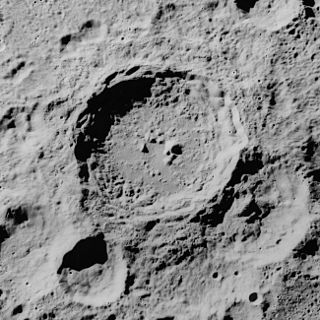 W
WOlcott is a relatively fresh crater on the far side of the Moon. It was named after American astronomer William Tyler Olcott. It lies to the south-southeast of the craters Seyfert and Polzunov, and to the north of Kostinskiy.
 W
WOstwald is a lunar impact crater on the far side of the Moon. It lies just to the east of the crater Guyot, and near the northern border of Ibn Firnas. Recht lies along its eastern rim.
 W
WPopov is a crater on the far side of the Moon, just beyond the eastern limb. It measures approximately 71.4 kilometers in diameter and is located along the very edge of the area of surface that is sometimes brought into view of the Earth during periods of favorable libration and illumination. However even at such times it is not prominent and can only be viewed edge-on.
 W
WRecht is a small impact crater on the far side of the Moon. It was named after the American mathematician and astronomer Albert William Recht. Is lies across the eastern rim of the much larger crater Ostwald. To the northeast of Recht is Meshcherskiy.
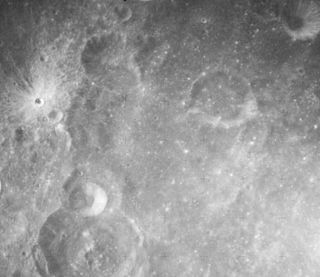 W
WSaenger is an ancient lunar impact crater that lies on the far side of the Moon, just beyond the eastern limb. It was named after Austrian rocketry scientist Eugen Sänger. To the west-northwest is the crater Erro, and due north lies Moiseev. To the northeast is Al-Khwarizmi.
 W
WSeyfert is a prominent lunar impact crater that is located on the far side of the Moon. It was named after American astronomer Carl Keenan Seyfert. It lies behind the eastern limb of the Moon, to the east of the crater Espin. Just to the north of Seyfert is the crater Harriot and equally close to the south is Polzunov.
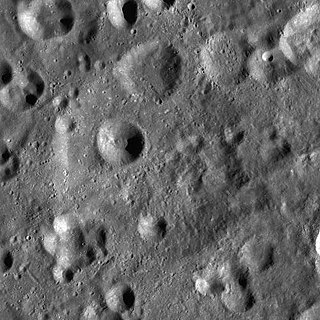 W
WShternberg is an eroded lunar impact crater on the Moon's far side. It lies just to the west-northwest of the crater Ohm, and is completely covered by higher-albedo material from the ray system that surrounds Ohm. To the west-southwest of Shternberg is Weyl, and to the west-northwest is Comstock. Less than one crater diameter to the northeast of Shternberg is Comrie.
 W
WSoddy is an eroded lunar impact crater lying on the far side of the Moon, invisible from the Earth, to the south-southeast of the prominent crater King. Material from the ray system surrounding King covers the sides and interior of Soddy. Less than one crater diameter to the west of Soddy is the smaller Heron.
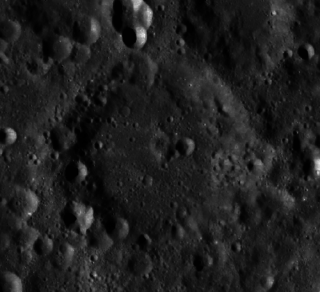 W
WVernadskiy is a lunar impact crater on the far side of the Moon, behind the visible eastern limb. It lies to the west-northwest of the smaller crater Siedentopf. To the south is Gavrilov, and much farther to the west is Meggers.
 W
WVetchinkin is an eroded lunar impact crater. It is located to the west-northwest of the huge walled plain Mendeleev, on the far side of the Moon. To the west-northwest of Vetchinkin lies the crater Meshcherskiy and to the south-southeast lies Green.
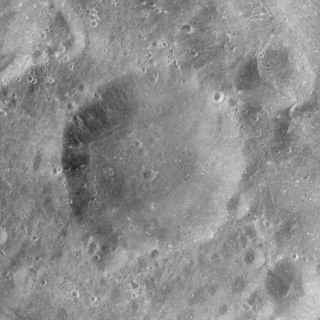 W
WViviani is a small lunar impact crater that lies on the far side of the Moon. It was named after Italian mathematician and physicist Vincenzo Viviani. It is located due west of the prominent crater King, and just to the southeast of Katchalsky.
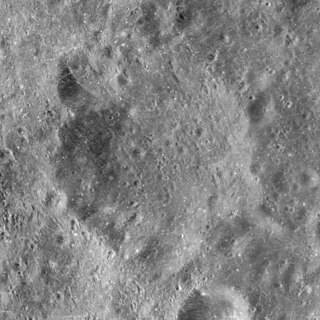 W
WZanstra is a lunar impact crater that is located on the far side of the Moon. It was named after the Dutch astronomer Herman Zanstra. It lies to the southeast of the crater pair Ibn Firnas and King, and northwest of Gregory. This is a low, eroded formation that is difficult to distinguish from its surroundings. The interior floor is level and not significantly impacted.
 W
WZasyadko is a small lunar impact crater located to the northeast of Mare Smythii. It lies beyond the eastern lunar limb in an area that is only visible during favorable librations. It is located entirely within the crater Babcock. To the southwest is McAdie. Zasyadko is a bowl-shaped formation with a relatively small interior floor. It is not significantly eroded along the rim.